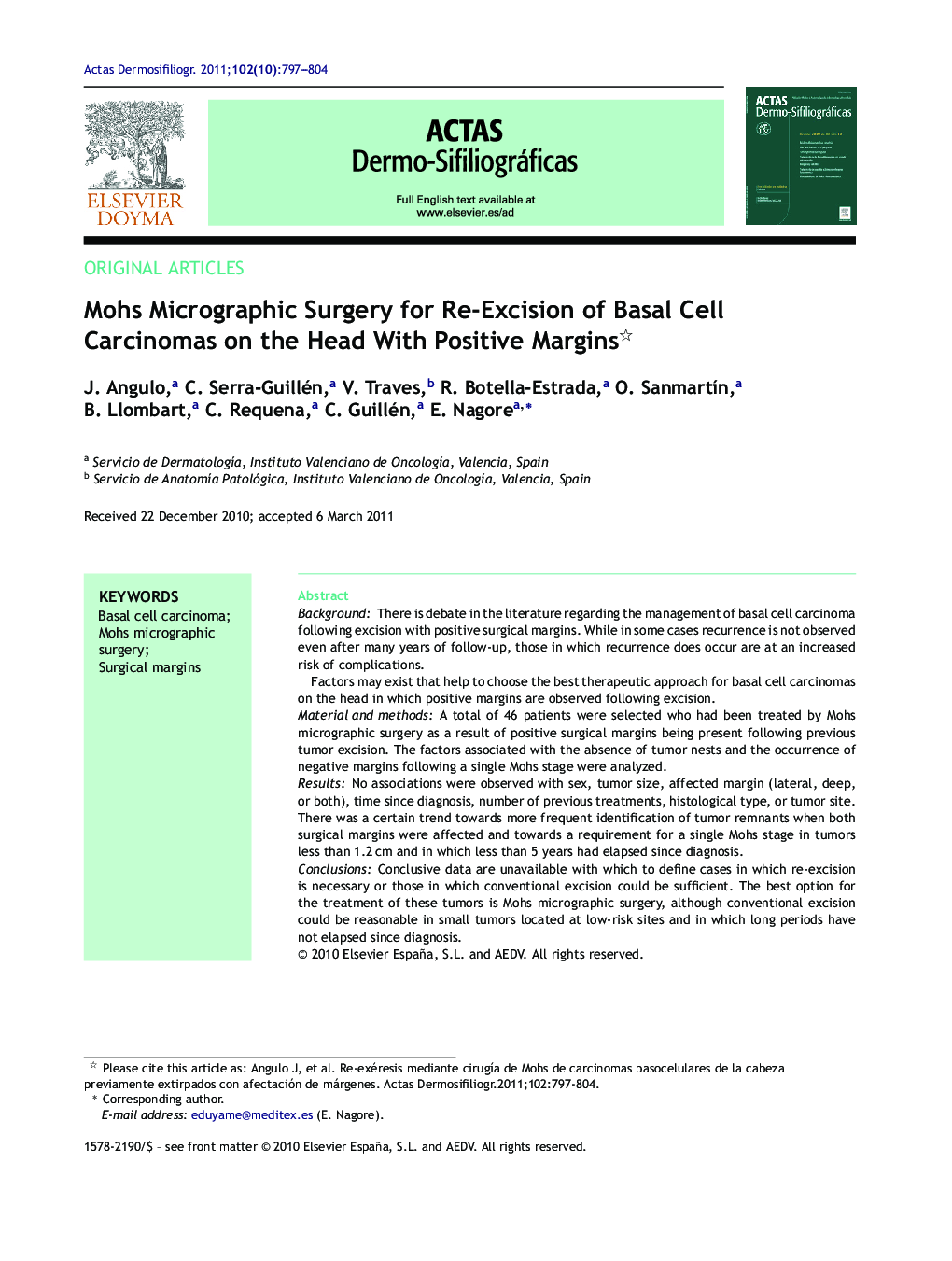| کد مقاله | کد نشریه | سال انتشار | مقاله انگلیسی | نسخه تمام متن |
|---|---|---|---|---|
| 3183534 | 1200705 | 2011 | 8 صفحه PDF | دانلود رایگان |

BackgroundThere is debate in the literature regarding the management of basal cell carcinoma following excision with positive surgical margins. While in some cases recurrence is not observed even after many years of follow-up, those in which recurrence does occur are at an increased risk of complications.Factors may exist that help to choose the best therapeutic approach for basal cell carcinomas on the head in which positive margins are observed following excision.Material and methodsA total of 46 patients were selected who had been treated by Mohs micrographic surgery as a result of positive surgical margins being present following previous tumor excision. The factors associated with the absence of tumor nests and the occurrence of negative margins following a single Mohs stage were analyzed.ResultsNo associations were observed with sex, tumor size, affected margin (lateral, deep, or both), time since diagnosis, number of previous treatments, histological type, or tumor site. There was a certain trend towards more frequent identification of tumor remnants when both surgical margins were affected and towards a requirement for a single Mohs stage in tumors less than 1.2 cm and in which less than 5 years had elapsed since diagnosis.ConclusionsConclusive data are unavailable with which to define cases in which re-excision is necessary or those in which conventional excision could be sufficient. The best option for the treatment of these tumors is Mohs micrographic surgery, although conventional excision could be reasonable in small tumors located at low-risk sites and in which long periods have not elapsed since diagnosis.
ResumenIntroducciónLa actitud ante los carcinomas basocelulares que han sido extirpados con márgenes afectos es controvertida en la literatura. Frente a casos que no recidivan incluso tras muchos años de seguimiento, hay riesgo de complicaciones en aquellos que sí lo hacen.Podrían existir factores que ayuden a escoger la mejor opción terapéutica para los carcinomas basocelulares localizados en la cabeza y extirpados con márgenes afectos.Material y métodosSe seleccionaron 46 pacientes tratados mediante cirugía de Mohs por haber sido previamente extirpados con afectación de márgenes. Se valoró qué factores se asociaron a la ausencia de restos tumorales y qué factores estaban asociados a la obtención de márgenes negativos con un único estadio.ResultadosNo se consiguió ninguna relación significativa con el sexo, el tamaño tumoral, el margen que estaba afecto (lateral, profundo o ambos), el tiempo de evolución, el número de tratamientos previos, el tipo histológico ni la localización. Hubo una cierta tendencia a encontrar más frecuentemente restos tumorales en las áreas perioficiales de tumores con ambos márgenes afectos, y a necesitar un único estadio en los tumores de menos de 1,2 cm y con menos de 5 años de evolución.ConclusionesNo existen datos concluyentes que permitan definir en qué casos puede no ser necesaria la reextirpación ni en cuáles puede ser suficiente una exéresis convencional. La mejor opción para el tratamiento de estos tumores es la cirugía de Mohs, aunque podría ser razonable realizar exéresis convencional en tumores pequeños de poco tiempo de evolución en localizaciones de bajo riesgo.
Journal: Actas Dermo-Sifiliográficas (English Edition) - Volume 102, Issue 10, December 2011, Pages 797–804